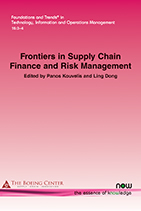Optimal Newsvendor IRM with Downside Risk
By Paolo Guiotto, Department of Mathematics, University of Padua, Italy, paolo.guiotto@unipd.it | Andrea Roncoroni, Department of Finance, ESSEC Business School, France, roncoroni@essec.edu
Abstract
We analyze the way behavioral preferences featuring downside risk aversion influence the optimal integrated risk management (IRM) of newsvendor revenues. Under the stylized assumption of perfectly correlated demand with financial hedge’s underlying, we show two remarkable facts. First, the simultaneous presence of a standard and a downside risk aversion blurs the relevance of an integrated approach to risk management under a conventional expected utility framework. Second, a generalized disappointment aversion utility represents an appropriate decision making setup for devising IRM strategies whose financial hedging component exhibits a relevant effect on the operational handling term.
Frontiers in Supply Chain Finance and Risk Management
This monograph contains eight thought-leading contributions on various topics related to supply chain finance and risk management: “Disruption Mitigation and Pricing Flexibility” by Oben Ceryan and Florian Lücker. “Optimal Newsvendor IRM with Downside Risk” by Paolo Guiotto and Andrea Roncoroni. “Competitive Forward and Spot Trading Under Yield Uncertainty” by Lusheng Shao, Derui Wang, and Xiaole Wu. “The Impact of Commodity Price Uncertainty on the Economic Value of Waste-to-Energy Conversion in Agricultural Processing” by Bin Li, Onur Boyabatlı, and Buket Avcı. “Corporate Renewable Procurement” by Selvaprabu Nadarajah. “Blockchain-Based Digital Payment Obligations for Trade Finance” by Jing Hou, Burak Kazaz, and Fasheng Xu. “Long-term Service Agreement in Power Systems” by Panos Kouvelis, Hirofumi Matsuo, Yixuan Xiao, and Quan Yuan. “The Bullwhip Effect in Servicized Manufacturers” by Jiang Shenyang, Jiang Zhibin, Niu Yimeng, and Wu Jing.

Companion
Foundations and Trends® in Technology, Information and Operations Management, Volume 16, Issue 3-4 Special Issue: Frontiers in Supply Chain Finance and Risk Management
See the other articles that are also part of this special issue.